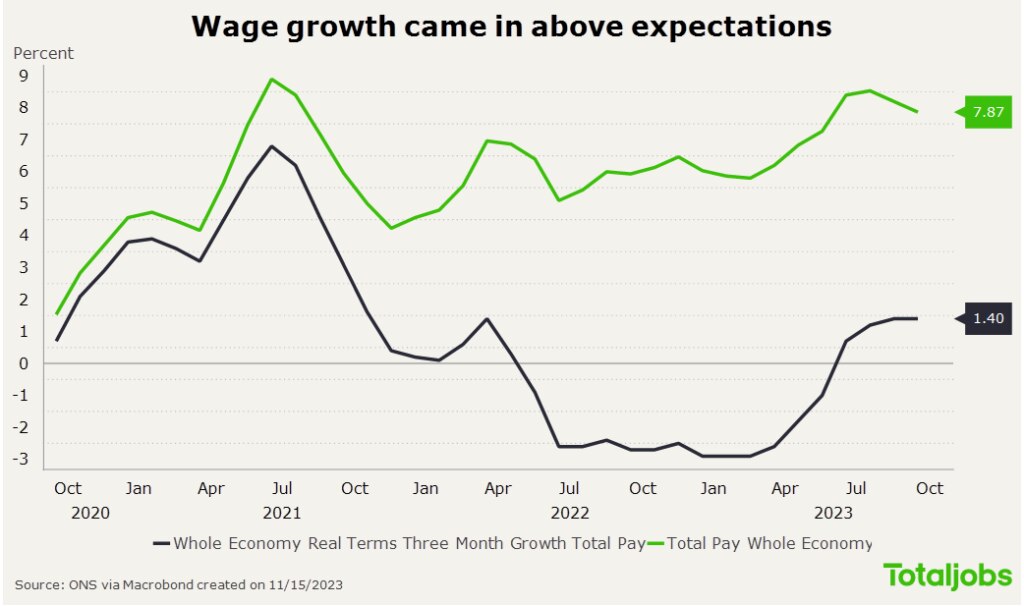As inflation comes down, regular pay is increasing in real terms
The latest ‘experimental’ figures by the ONS continue to show an easing labour market, and inflation has come down to 4.6% which means real pay showed positive annual growth.

The UK labour market held up despite challenges with the cost of living and rising interest rates. Additionally, the wages have also shown positive annual growth. In the three months to September, wages in the UK have grown 7.7%, excluding bonuses.
Inflation has come down to 4.6%, which means the UK government has met its target to halve inflation early. This was largely due to easing energy prices, however the inflation for food and beverages remains over 10%.
Unfortunately, the UK economy is stagnating as it showed no growth in Q3 2023. Experts are warning that the UK could be headed for a ‘stagflation’. The Chancellor’s Autumn Statement is expected to be delivered on the 22nd of November, which will lay out financial plans for 2024.
Key findings from the ONS data
- Over 30 million people are participating in the UK labour market, with estimated figures showing employment at 75.7%.
- Unemployment rate remains largely unchanged since it reached 4.2%. Similarly, economic inactivity rate remained at 20.9% in the third quarter of 2023.
- The number of job openings kept falling for the 16th consecutive month but remain above pre-pandemic levels.
- According to Totaljobs’ Hiring Trends Index, finding the right talent is taking businesses 6.1 weeks on average in Q3. This is especially a challenge in the public sector.
- Due to falling inflation, real pay grew by 1.3% year on year.

Public sector wages caught up with the private sector
The ONS said that the annual average regular pay growth for the public sector was 7.3% in July to September 2023 and 7.8% for the private sector. These marked the largest annual growth rates seen outside of the Covid-19 pandemic period.
After months of strike action, public sector workers such as teachers, police and doctors were offered pay rises of between 5%-7%. Meanwhile, the finance and business services sector saw the largest annual regular growth rate at 9.6%.
UK Salary and Benefit Trends: Discover the salary and benefit trends shaping recruitment in your industry in 2023. Compare your offering and find out new ways to attract talent.
UK Quality of Life Index: Find out what your city ranks #1 for and get tips for attracting a new talent pool open to relocation.
Labour market economist Julius Probst commented:
Due to data issues with the Labour Force Survey, the ONS ceased publication of some of its labour market data two months ago. The national statistics office is currently publishing an ‘experimental’ unemployment rate instead, which is based on HMRC payroll figures and other data. While this experimental unemployment rate stands at 4.2% right now, we cannot have full confidence that this number is 100% accurate. The fact that we have to rely on potentially unreliable data is concerning during a time when the labour market is clearly weakening. The risk of stagnation in the year to come is high. The Bank of England has made it abundantly clear that they want to bring inflation down now, even at the risk of slow or negative growth.
Julius ProbstLabour Economist
Totaljobs’ overview of the recruitment landscape
Our latest Hiring Trends Index (Q3 2023) takes an in-depth look into the economic outlook of the UK with a focus on green jobs. This edition provides an understanding of the demand for green jobs and skills by businesses and candidate attitudes regarding green employers.
According to our data;
- More than a third (36%) of businesses increased recruitment in the third quarter of 2023.
- 59% of businesses are confident they will recruit the people they need in Q4 2023, rising from 53% reported in Q4 2022.
- According to Totaljobs data, despite a general slowdown in hiring, the demand for green roles continues to increase (677% between 2019 and 2023).
- Over 1 in 5 (23%) companies are increasing the number of green roles within their business.
- Over half (58%) of companies have or are in the process of implementing a sustainability framework. Among businesses that have already established one, 84% report that their company has experienced benefits.
- The average time to hire stands at 6.1 weeks, which is lower than 6.4 weeks at the beginning of the year.

Totaljobs’ Hiring Trends Index rounds up the latest quarterly insights from the UK labour market and provides a first look at what’s happening in recruitment. In this edition, we look at the third quarter of 2023 with a focus on sustainability and green roles.
- Read our Hiring Trends Index to learn more about the demand in green roles and skills, and candidate expectations from employers when it comes to sustainability.

